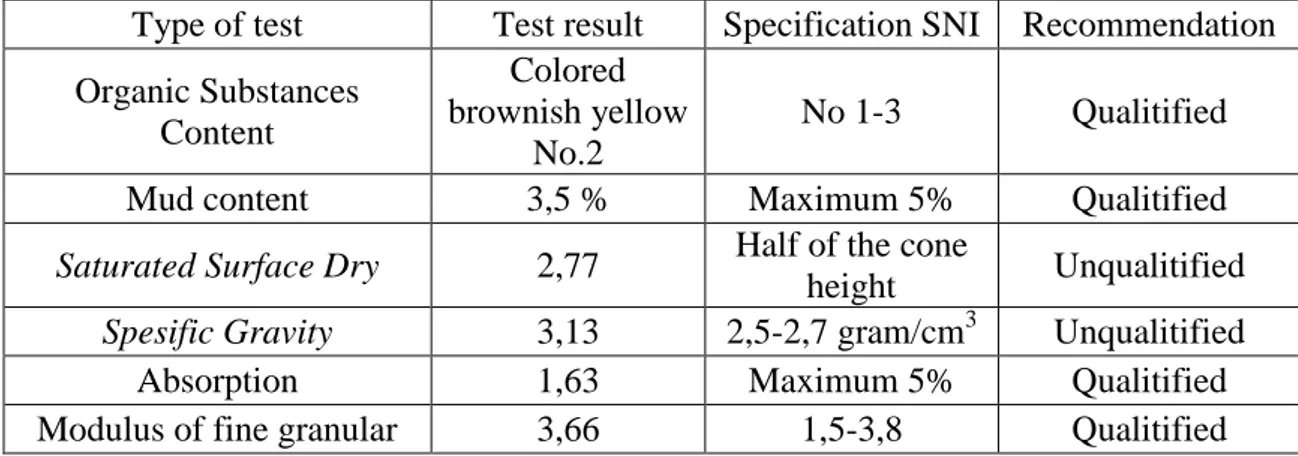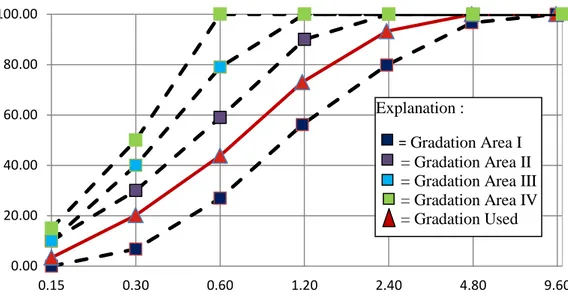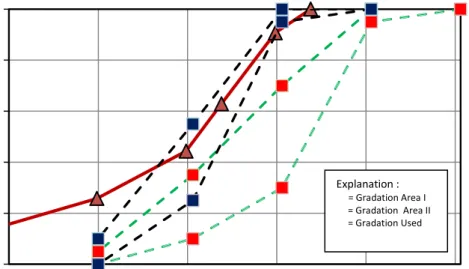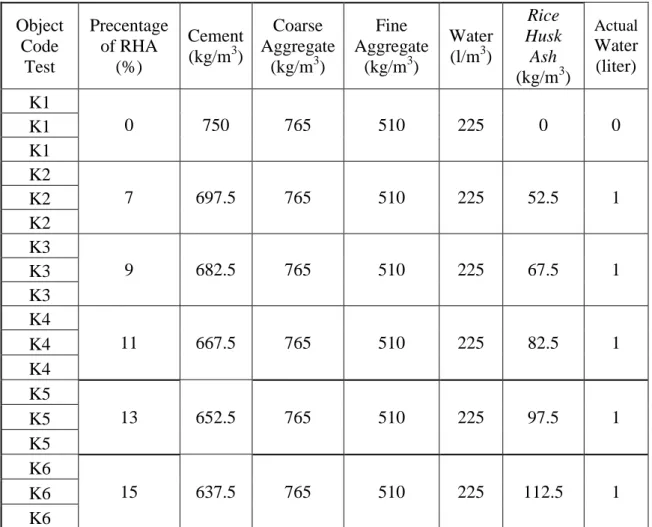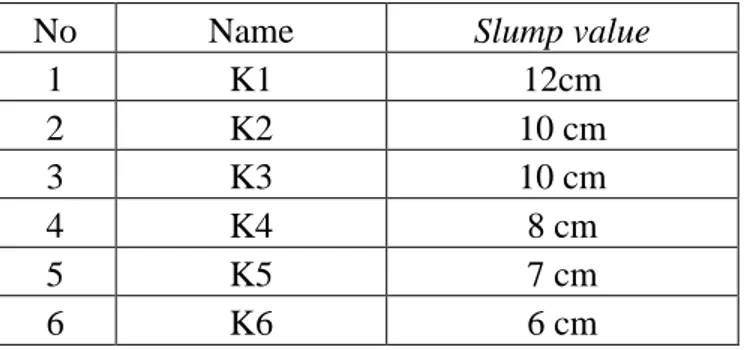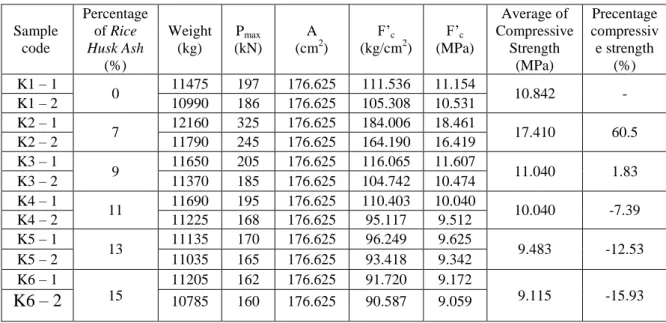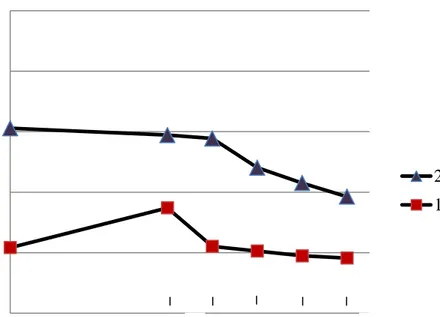EXPERIMENT OF EARLY AGE STRENGTH CONCRETE USING RICE HUSK ASH
Arranged as one of the requirements of completing stratum I program in Civil Engineering Department of Engineering Faculty
Submitted by:
WAFIQOTUL KARIMAH NIM : D 100 112 006
CIVIL ENGINEERING PROGRAM ENGINEERING FACULTY
UNIVERSITAS MUHAMMADIYAH SURAKARTA 2017
1
EXPERIMENT OF EARLY AGE STRENGTH CONCRETE USING RICE HUSK ASH
Abstrak
Beton merupakan suatu bahan komposit (campuran) dari beberapa material, yang bahan utamanya terdiri dari campuran antara semen, aggregat halus, aggregate kasar, air atau tanpa bahan tambah lain dengan perbandingan tertentu. Peningkatan mutu beton dapat dilakukan dengan memberikan bahan tambah, dari beberapa bahan tambah yang ada antaranya adalah abu sekam padi selain dapat meningkatkan mutu beton, juga dapat mempengaruhi tegangan dan regangan pada beton. Berdasarkan uraian di atas penelitian ini akan menggunakan abu sekam padi sebagai pengganti sebagian dari semen dengan presentase 0 %, 7 %, 9 %, 11 %, 13 %, dan 15 % dengan umur beton 1 hari dan 28 hari sebagai perbandingan. Rencana faktor air semen (fas) yang digunakan adalah 0.3. Dari hasil penelitian Hasil uji kuat tekan pada umur 1 hari nilai kuat tekan yang diperoleh pada abu sekam padi diatas kuat tekan beton normal (0%) pada umur 1 hari diperoleh 10.842 MPa sedangkan pada umur 28 dapat mencapai 30.573 MPa, Pada penggunaan 7% abu sekam padi pada umur 1 hari diperoleh 17,410 MPa sedangkan pada umur 28 hari diperoleh 29.441 MPa, penggunaan abu sekam padi 9% pada umur 1 hari diperoleh 11,040 MPa sedangkan pada umur 28 hari diperoleh 28,875 MPa. Sedangkan pada penggunaan 11% abu sekam padi pada umur 1 hari diperoleh 10,276 MPa dan pada umur 28 hari diperoleh 24,062 MPa, penggunaan 13% abu sekam padi pada umur 1 hari diperoleh 9,483 MPa dan pada umur 28 hari diperoleh 21,515 MPa, dan Pada penggunaan 15% abu sekam padi pada umur 1 hari diperoleh 9.115 MPa dan pada umur 28 hari diperoleh 19.250 MPa. Untuk kualitas beton umur 1 hari tingkat abu sekam padi paling baik untuk memperkuat beton adalah 7% dan pada umur 28 hari adalah 0%. Kekuatan tekan akan menurun atau sama dengan kuat tekan beton normal, sehingga penggunaan abu sekam padi dengan persentase tinggi memerlukan waktu yang lambat untuk pengeringan.
Kata kunci : abu sekam padi, beton, kekuatan beton pada umur awal
Abstact
Concrete is a composite material (mixture) from some materials, which the main ingredient consist of a mixture of cement, fine aggregate, coarse aggregate, water and or whitout other added ingredients with a certain ratio. Improvement of the quality of concrete can be done by providing added ingredients, from some of the added ingredients such as rice husk ash in addition to improving the quality of concrete, can also affect the stress and strain on the concrete. Based on the above description, this study will use rice husk ash as a substitute of cement with a percentage of 0%, 7%, 9%, 11%, 13%, and 15% with concrete age is 1 day and 28 days to comparasion. The used water cement ratio (fas) design is 0.3. The result of testing compressive strength at the age of 1 day the value of compressive
2
strength obtained on rice husk ash above on compressive strength of normal concrete (0 %) at 1 day age obtained 10.842 MPa meanwhile at 28 age can reach until 30.573 MPa, on 7 % use of Rice Husk Ash at 1 day age obtained 17.410 MPa meanwhile at 28 day age obtained 29.441 MPa, on 9 % use of Rice Husk Ash at 1 day age obtained 11.040 MPa meanwhile at 28 days age obtained 28.875 MPa. Meanwhile on 11 % use of Rice Husk Ash at 1 day age obtained 10.276 MPa and at 28 days age obtained 24.062 MPa, on 13 % use of Rice Husk Ash at 1 day age obtained 9.483 MPa and at 28 days age obtained 21.515 MPa, and on 15 % use of Rice Husk Ash at 1 day age obtained 9.115 MPa and at 28 days age obtained 19.250 MPa. For the quality of concrete age of 1 day the level of rice husk ash is best to strengthen the concrete is 7% and at the age of 28 days is 0%. The compressive strength will decrease or same as compressive strength of normal concrete, cause the use of rice husk ash with high percentage will need the time that slow for drying.
Keywords : concrete, early age strength concrete, rice husk ash
1. INTRODUCTION
Concrete is a composite material (mixture) from some materials, which the main ingredient consist of a mixture of cement, fine aggregate, coarse aggregate, water and or whitout other added ingredients with a certain ratio. Because the concrete is a composite, the quality of the concrete depends on the quality of each material (Kardiyono Tjokrodimulyo, 2007). The use of concrete as the main ingredient of the current construction is no doubt it's superiority. Concrete is now experiencing many developments, both in the manufacture of concrete mixes and in the construction. Because the technology is getting better then the use of concrete is required to increase in terms of quality and quantity, so it takes a way to increase the strength of concrete.The quicker the concrete will harden it can reduce over high cost and speed up the work process in the implementation of construction work with qualified quality.
Improvement of the quality of concrete can be done by providing added ingredients, from some of the added ingredients such as rice husk ash in addition to improving the quality of concrete, can also affect the stress and strain on the concrete. Rice husk ash has been studied by some researchers who claim that rice husk ash contains a high enough element of silica. Malawi (1996) conducted research on the potential of rice husk ash as pozzolan material on cement mortar.
3
Pozzolan is a material that has a high silica content. Rice husk ash contains silica compound (SiO2) of 88.92 % so it can be classified as pozzollan (Dharma Putra, 2006).
Based on the above description, this study will use Rice Husk Ash as a substitute of cement with a percentage of 0 %, 7 %, 9 %, 11 %, 13 %, and 15 % with concrete age is 1 day and 28 days to comparasion.
2. RESEARCH METHOD
In this research is the research stages arranged into five stages, that: 2.1 Stage I. Preparation equipment and material supply
This stage is the stage of preparation of laboratory research are the preparation of tools and material preparation such as provision of concrete building blocks which include cement, water, fine aggregate (sand), coarse aggregate (crushed stone), and the rice husk ash.
2.2 Stage II. Material Test
Examination of the material held on a concrete base material to be used as a test object include: cement, water, fine aggregate (sand), coarse aggregate (crushed stone), and rice husk ash. Examination of the material of the examination and inspection density material.
2.3 Stage III. Mix Design and Makes Specimens
Design and manufacture of the concrete mix design using a mixture (mix design) that has been planned, and has tested its slump. The test object in the form of concrete cylinders made total number of 24 pieces. Treatment of the test specimen by means silenced in the room for 1 day and 28 days. 2.4 Stage IV. Specimen test
This stage testing of the mechanical characteristics of the concrete form of tensile strength test and press the appropriate testing procedures and the calculation of SNI and ASTM standards.
2.5 Stage V. Analysis and Discussion
The results of tests performed in stage III and IV data analysis. Data analysis is the discussion of the results, the data is processed and analyzed by presenting the results of research in the form of tables and graphs and
4
to compare one with the other. Based on this analysis, it will get a conclusion regarding the compressive strength and tensile strength of concrete.
3. RESEARCH RESULT AND DISCUSSION 3.1 The test result of fine aggregate
The results obtained at the time of the study are presented in Table V.1 Results of Fine Aggregate Testing.
Table 3.1 Results of Fine Aggregate Test
Type of test Test result Specification SNI Recommendation Organic Substances Content Colored brownish yellow No.2 No 1-3 Qualitified
Mud content 3,5 % Maximum 5% Qualitified
Saturated Surface Dry 2,77 Half of the cone
height Unqualitified
Spesific Gravity 3,13 2,5-2,7 gram/cm3 Unqualitified
Absorption 1,63 Maximum 5% Qualitified
Modulus of fine granular 3,66 1,5-3,8 Qualitified
(Source: test results)
The results of fine aggregate grading test in accordance with the requirements of ASTM C33-97 can be seen in table V.2. Result of fine aggregate gradation.
Table 3.2. Results of Fine Aggregate Gradation Test
No Sieve Size (mm) Weight Sieve (gr) Sieve + Sand (gr) Weight sand (gr) Weight Correction (gr) Percentage Holding sand (%) Percentage Cumulative (%) Retained Pass 1. 9.5 410 410 0 0 0,00 0.00 100 2. 4.75 420 420 0 0 0,00 0.00 100 3. 2.36 430 460 30 30 6.74 6.74 93.26 4. 1.18 355 445 90 90 20.22 26,97 73.03 5. 0.6 335 465 130 130 29.21 56.18 43.82 6. 0.3 320 425 105 105 23.60 79.78 20.22 7. 0.15 390 460 75 75 16.85 96.63 3.37 8. 0 380 395 15 15 3.37 100 0 ∑ = 445
5
Based on table 3.2 the results of fine aggregate gradation testing can be described with gradation graph as follows:
Based on figure 3.1 the graph of the relationship between the sieve size and the percentage of cumulative passes on fine aggregates including the gradation area II. According to Tri Mulyono (2003), the fine aggregate on the gradation area II is included in the slightly coarse sand.
3.2 Coarse Aggregate Test
The rough aggregate test in this study was conducted to determine aggregate wear, aggregate weight and aggregate gradation. The results of the test can be seen in Table 3.4 Results of coarse Aggregate Test.
Table 3.4 Results of coarse Aggregate Test.
Type of test Test result Standart SNI recommendation
Wearing gravel aggregate 32% 40% Qualified
Bulk Spesific Gravity 2,64 2,5 – 2,7 gr/cm3 Qualified
absorptation 2,63 < 3% Qualified
Modulus of fine granular 8 5-8 Qualified
(Source: test result)
0.00 20.00 40.00 60.00 80.00 100.00 0.15 0.30 0.60 1.20 2.40 4.80 9.60 Sieve Size (mm) Pe rc en tage Cumul at ive Fin e Aggr egat e(%) Explanation : = Gradation Area I = Gradation Area II = Gradation Area III = Gradation Area IV = Gradation Used
6
Table 3.5 Results of Coarse Aggregate Gradation Test
No Sieve Size (mm) Weight of sieve (gr) Weight of sieve + split (gr) Weight of split (gr) Weight of split Corrected (gr) Precentage of split retainded (%) Cumulative Precentage (%) Retained Pass 1 25 510 510 0 0 0 0 100 2 19 60 550 90 90 9.28 9.28 9.72 3 12.5 400 670 270 270 27.84 37.11 62.89 4 9.5 400 580 180 180 18.56 55.67 44.33 5 4.75 360 540 180 180 18.56 74.23 25.77 6 2.36 430 530 100 100 10.31 84.54 15.46 7 1.18 360 440 80 80 8.25 92.78 7.22 8 0.6 320 380 60 60 6.19 98.97 1.03 9 0.3 320 330 10 10 1.03 100 0 10 0.15 370 370 0 0 0 100 0 11 Pan 440 440 0 0 0 100 0 Total 970 970 100 752.58 347.42
(Source: test results)
Based on table 3.5 the results of coarse aggregate gradation testing can be described with gradation graph as follows:
Figure 3.2 The graph of the relationship between the size and the percentage of the coarse aggregates passes through.
0 20 40 60 80 100 2.4 4.8 9.6 19.2 38.4 76.8 Sieve Size (mm) Perc ent C um ul at ive Pas s (%) Explanation : = Gradation Area I = Gradation Area II = Gradation Used
7 3.3 Rice Husk Ash Test
Rice Husk Ash comes from Baki Sukoharjo, Central Java which is a combustion waste from rice husk used as fuel in the process of burning raw bricks, in the process of making bricks. This test is conducted to determine the chemical element contained in Rice Husk ash. In this research the data of Husk ash rice testing is available and obtained from previous Research of Udayana University Analytical Laboratory, in 2006 that is:
Table 3.6. Result of Rice Husk Ash Test Compotition Precentage %
SiO2 88.92 %
Fe2O3 0.608 %
Al2O3 0.674
(Dharma Putra, 2006)
From the result of Rice Husk Ash test, it can be concluded that Rice Husk Ash can be used as pozzolan because it contains SiO2 + Fe2O3 + Al2O3 more than 70 % according to the required pozzolan quality ( Dharma Putra, 2006).
3.4 The Mixture Plan Calculation
The concrete mix design used in this study uses The British Mix Design Method. The planned compressive strength is 20 MPa with a fas value of 0.3.In this study, a mixture of Rice Husk Ash with 0%, 7%, 9%, 11%, 13% and 15% variation was performed using a compressive strength test at the age of 1 day and 28 days for comparison.The proportion of the mixture can be seen in table 3.7 as follows:
8
Table VI.2 The proportion of mixture of concrete for each variation of Rice Husk ash for 1 specimen with diameter of 15 cm and 30 cm of high in in kg/m3
Object Code Test Precentage of RHA (%) Cement (kg/m3) Coarse Aggregate (kg/m3) Fine Aggregate (kg/m3) Water (l/m3) Rice Husk Ash (kg/m3) Actual Water (liter) K1 0 750 765 510 225 0 0 K1 K1 K2 7 697.5 765 510 225 52.5 1 K2 K2 K3 9 682.5 765 510 225 67.5 1 K3 K3 K4 11 667.5 765 510 225 82.5 1 K4 K4 K5 13 652.5 765 510 225 97.5 1 K5 K5 K6 15 637.5 765 510 225 112.5 1 K6 K6 Note:
K1 = Specimen of Concrete without Rice Husk Ash 0% K2 = Specimen of Concrete added Rice Husk Ash 7 % K3 = Specimen of Concrete added Rice Husk Ash 9 % K4 = Specimen of Concrete added Rice Husk Ash 11 % K5 = Specimen of Concrete added Rice Husk Ash 13 % K6 = Specimen of Concrete added Rice Husk Ash 15 %
3.5 Slump Test
Each variation of Rice Husk Ash content on the concrete mixture was tested for slump. In this study the slump value is needed to know the level of concrete performance of each variation of Rice Husk Ash content on concrete mixture. From the table of mix design (IV.1) the result of slump can be seen in table 3.8.
9 Table 3.8 Slump Test Results
No Name Slump value
1 K1 12cm 2 K2 10 cm 3 K3 10 cm 4 K4 8 cm 5 K5 7 cm 6 K6 6 cm
From data on table 3.8 can be drawn in graphics the result value of slump as follow:
Figure 3.3 Slump value
Based on the data that we get at the slump testing, take the conclusion that from the six variety of concrete mixture between normal concrete (without rice husk ash), concrete with the percentage of rice husk 7 %, 9 %, 11 %, 13 %, and 15 % all of them, the value of slump is still suitable with planned slump. So this research is not affecting the value of slump.
K1 K2 K3 K4 K5 K6 0 3 6 9 12 15 0% 7% 9% 11% 13% 15% Slu m p Va lue (cm ) Variation of RHA(%)
10 3.6 Compressive Strength Test of Concrete
The result of compressive strength test on specimen age 1 day with diameter 15 cm and high 30 cm can be seen in table 3.9 .
Table 3.9 Compressive strength Calculation Analysis on Age 1 day
(Source: result of research)
a. Test result and analysis of concrete compressive strength at 28 day age The result of the research of concrete compressive strength on specimen 28 day age with the diameter 15 cm and height 30 cm can be seen on table V.7.
Tabel 3.10 Compressive strength Calculation Analysis on age 28 days
Sample code Percentage of Rice Husk Ash (%) Weight (kg) Pmax (kN) Pmax (kg) A (cm2) F’c (kg/cm2) F’c (MPa) Average of Compressive Strength (MPa) K1 – 1 0 11370 540 54000 176.625 305.732 30.573 30.573 K2 – 1 7 12080 520 52000 176.625 294.409 29.441 29.441 K3 – 1 9 12460 510 51000 176.625 288.747 28.875 28.875 K4 - 1 11 12290 425 42500 176.625 240.623 24.062 24.062 K5 - 1 13 12480 380 38000 176.625 215.145 21.515 21.515 K6 - 1 15 12465 340 34000 176.625 3192.498 19.250 19.250
(Source: result of research)
Sample code Percentage of Rice Husk Ash (%) Weight (kg) Pmax (kN) A (cm2) F’c (kg/cm2) F’c (MPa) Average of Compressive Strength (MPa) Precentage compressiv e strength (%) K1 – 1 0 11475 197 176.625 111.536 11.154 10.842 - K1 – 2 10990 186 176.625 105.308 10.531 K2 – 1 7 12160 325 176.625 184.006 18.461 17.410 60.5 K2 – 2 11790 245 176.625 164.190 16.419 K3 – 1 9 11650 205 176.625 116.065 11.607 11.040 1.83 K3 – 2 11370 185 176.625 104.742 10.474 K4 – 1 11 11690 195 176.625 110.403 10.040 10.040 -7.39 K4 – 2 11225 168 176.625 95.117 9.512 K5 – 1 13 11135 170 176.625 96.249 9.625 9.483 -12.53 K5 – 2 11035 165 176.625 93.418 9.342 K6 – 1 15 11205 162 176.625 91.720 9.172 9.115 -15.93 K6 – 2 10785 160 176.625 90.587 9.059
11
Based on average compressive strength and variation of Rice Husk ash, so can be drawn in graph below:
Figure 3.4 The Graph of Concrete Compressive Strength (MPa) and variation percentage of Rice Husk Ash.
Based on average of compressive strength and variation percentage of Rice Husk Ash can be conclude that the optimal percentage of Rice Husk Ash is 7 %, the more of Rice Husk Ash that used will be lower the compressive strength of concrete, with the percentage of Rice Husk Ash more than 11 % the result of compressive strength is equivalent with normal concrete without using Rice Husk Ash.
Can be seen on table V.6 above on compressive strength of normal concrete (0 %) at 1 day age obtained 10.842 MPa meanwhile at 28 age can reach until 30.573 MPa, on 7 % use of Rice Husk Ash at 1 day age obtained 17.410 MPa meanwhile at 28 day age obtained 29.441 MPa, on 9 % use of Rice Husk Ash at 1 day age obtained 11.040 MPa meanwhile at 28 days age obtained 28.875 MPa. Meanwhile on 11 % use of Rice Husk Ash at 1 day age obtained 10.276 MPa and at 28 days age obtained 24.062 MPa, on 13 % use of Rice Husk Ash at 1 day age obtained 9.483 MPa and at 28 days age
0 10 20 30 40 50 0 1 2 3 4 5 6 7 8 9 10 11 12 13 14 15 16 Concr ete Com p re ssi ve S tr en gt h ( M P a )
Variation of Rice husk Ash (%)
28 Days 1 Day
12
obtained 21.515 MPa, and on 15 % use of Rice Husk Ash at 1 day age obtained 9.115 MPa and at 28 days age obtained 19.250 MPa.
So the difference of compressive strength is different on each variation of Rice Husk Ash, with the optimal use of Rice Husk Ash on concrete is 7 % from weight of cement will add strength on concrete which is quite significant, and the percentage of Rice Husk Ash that more than 11 %, the compressive strength will decrease or same as compressive strength of normal concrete, cause the use of Rice Husk Ash with high percentage will need the time that slow for drying.
According to the reference of the (Dharma putra, 2006) in his research, addition of Rice Husk Ash to increase the compressive strength. In other words, it can anticipate the degradation of concrete quality. But the addition of Rice Husk Ash will decrease slump value. So in my research, not similar with (Dharma putra, 2006 ) research.
4. CLOSE
4.1 Conclusion
Based on the results of research and discussion that has been described, it can be concluded into several, among others, as follows:
4.1.1 The compressive strength of concrete at the age of 1 day and 28 days using rice husk ash additive.
a. On 0 % use of rice husk ash at 1 day age obtained 10.842 Mpa meanwhile at 28 days age can reach until 30.573 Mpa.
b. On 7 % use of rice husk ash at 1 day age obtained 17.410 Mpa meanwhile at 28 days age obtained 29.441 Mpa.
c. On 9 % use of rice husk ash at 1 day age obtained 11.040 Mpa meanwhile at 28 days age obtained 28.875 Mpa.
d. On 11 % use rice husk ash at 1 day age obtained 10.276 Mpa meanwhile at 28 days age obtained 24.062 Mpa.
13
e. On 13 % use rice husk ash at 1 day age obtained 9.483 Mpa meanwhile at 28 days age obtained 21.515 Mpa.
f. On 15 % use rice husk ash at 1 day age obtained 9.115 Mpa meanwhile at 28 days age obtained 19.250 Mpa.
4.1.2 For the quality of concrete age of 1 day then the level of rice husk ash is best to strengthen the concrete is 7% and at the age of 28 days is 0%. 4.1.3 From the research conducted, the addition of rice husk ash on concrete
mixture did not increase compressive strength in concrete age 1 day or 28 days. So there needs to be more research with other additive materials.
4.2 Advice
4.2.1 For further research on the manufacture of concrete should be tried by using a type of PPC cement or Portland type III.
4.2.2 For research Rice Husk Ash should use low fas and not greater than 7% rice husk ash level.
4.2.3 Preferably before testing the compressive strength to produce the maximum compressive strength is capping process first done. 4.2.4 Need futher research by using other additive materials that contain
high pozzolan.
REFERENCE
Antoni dan Nugraha, P. (2007), Teknologi Beton, C.V.Andi Offset, Yogyakarta. Berqa, borris. 2012. Pengaruh Penggunaan Fly Ash Pada Beton mutu normal dan
mutu tinggi ditinjau dari kuat tekan dan absorbsi. Vol 10,no 1. tersedia:
//ejournal.umm.ac.id/index.php/jmts/article/view/1206 (8 maret 2016). Dharma Putra, Jurnal, 2006, Penambahan Abu Sekam Pada Beton dalam
Mengantisipasi Kerusakan Akibat Magnesium Sulfat pada Air Laut, Jurnal
Ilmiah Teknik Sipil Vol. 10, No. 2 Juli 2006.
DPU, 1990, Metode Pengujian Tentang Ana-lisis Saringan Agregat Halus dan
14
DPU, 1990, Metode Pengujian Berat Jenis dan Penyerapan Air Agregat Kasar , SK SNI 03- 1969-1990 , yayasan LPMB, Bandung.
DPU, 1990, Metode Pengujian Berat Jenis dan Penyerapan Air Agregat Halus , SK SNI 03- 1970-1990 , yayasan LPMB, Bandung.
DPU, 1990, Metode Pengujian Slump Beton, SK SNI 03-1972-1990, yayasan LPMB, Bandung
DPU, 1990, Metode Pembuatan dan Perawatan Benda Uji Beton di
Laboratorium, SK SNI 03-2493-1991, yayasan LPMB, Bandung.
DPU, 1990, Metode Pengujian Kuat Tekan Beton, SK SNI 03-6486-1990, Yayasan LPMB, Bandung.
DPU, 1991, Bahan Tambah Untuk Beton, SK SNI 03-2495-1991, Yayasan LPMB, Bandung.
DPU, 1992, Metode Pengujian Kotoran Organik dalam Pasir Untuk Campuran
Beton, SK SNI 03-2816-1992, Yayasan LPMB, Bandung.
DPU, 2002, Metode Pengujian Untuk Mengukur Nilai Kuat Tekan Beton Pada
Umur Awal Dan Memproyeksikan Kekuatan Pada Umur Berikutnya, SK
SNI 03-6405-2002, Yayasan LPMB, Bandung.
DPU, 2008, Cara Uji Keausan Aggregat Dengan Mesin Abrasi Los Angeles, SK SNI 03-2417-2008, Yayasan LPMB, Bandung.
Malawi, R., 1996, Potensi Abu Sekam Padi sebagai Bahan Pozzolan pada mortal
semen, Tugas Akhir S-1 Jurusan Teknik Sipil UGM, Yogyakarta.
Mulyono, Tri 2003, Teknologi Beton, Penerbit ANDI Yogyakarta. Sukirman, Silvia, 2003, Beton Aspal Campuran Panas, Jakarta: Granit.
Supartono, F.X., 1998, Mengenal dan Mengetahui Permasalahan pada Produksi
Beton Berkinerja Tinggi, artikel ilmiah, UI, Jakarta.
